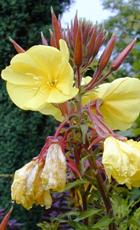
Plant Part: Seed
Extraction: Cold Pressed
Growing Practice: Ethical
Country of Origin: USA
Refractive Index: 1.450 to 1.530 @ 20° C
Specific Gravity: 0.9100 to 0.9500 @ 20° C.
Appearance: yellow liquid
BioChemicals: 7-10% gamma linolenic acid (GLA), vitamins, minerals
Saturated fatty adics (typically 8%): palmitic acid (6.5%), stearic acid (1.3%), arachidic acid (0.3%)
Monounsaturated fatty acids (typically 0.2%): eicosenoic acid (0.2%)
Polyunsaturated fatty acids (typically 80%): linoleic acid (65-75%), α-linolenic acid (0.2%), γ-linolenic acid (8-10.5%) [GLA]
CAS No: 65546-85-2
Evening Primrose Oil is extracted from the mature seeds by expression, with about a 25% yield. About 7-10% of the oil consists of the rare essential fatty acid γ-linolenic acid, commonly known as GLA.
Several other oils, including borage oil, and black currant oil, have higher levels of GLA than Evening Primrose Oil.
Folklore and Traditional Plant Uses
Native North American use includes seed infusions for wound healing, and leaves and roots. Little used in Europe but it was described as early as 1629.
Therapeutic properties for external use
- dry scaly skin
- dandruff
- helps with psoriasis
- helpful for eczema
- accelerates wound healing
Cosmetic Use
- used in antiwrinkle preperations at about 20%

Evening Primrose Oil can oxidize on exposure to air and light, so it should be stored in a cool, dark place with oxygen excluded.
The information provided on these pages is not a substitute for necessary medical care, nor intended as medical advice. Always keep carriers and bases tightly closed and in a cool, dark place, out of reach of children. If redness or irritation occurs when applied to the skin, stop using immediately and contact your health provider if necessary.![]()
all images and content copyright ©2000—2020 by suzumebachi design and samara botane





